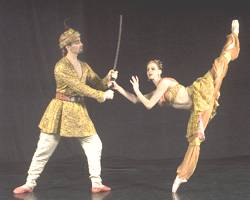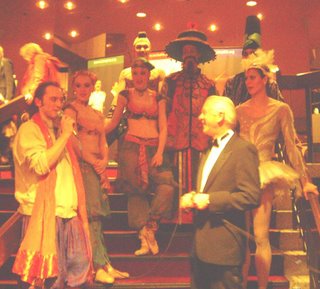 Sacramento Ballet's "Scherherazade"
Sacramento Ballet's "Scherherazade"Sacramento Bee preview caption (left): Jack Hansen and Kirsten Bloom will dance in the Sacramento Ballet performance of "Scheherazade," choreographed by Kathryn Posin.
Sacramento Bee/ Jay Mather
 Taking questions after Friday night's performance, March 31, 2006. Left to right; Stefan Calka (Sinbad), Nicole Haskins (Sea Spirit, Attendant of the Moon), Tarah Finley (Harem Girl), Joo Hwan Cho (Genie), Kermit Allen (King Badur), J. Benjamin Schreivogel (Vizier), Ilana Goldman (Rukh Bird), Ron Cunningham (Co-Artistic Director).
Taking questions after Friday night's performance, March 31, 2006. Left to right; Stefan Calka (Sinbad), Nicole Haskins (Sea Spirit, Attendant of the Moon), Tarah Finley (Harem Girl), Joo Hwan Cho (Genie), Kermit Allen (King Badur), J. Benjamin Schreivogel (Vizier), Ilana Goldman (Rukh Bird), Ron Cunningham (Co-Artistic Director).How long did it take to practice for this show? Benjamin Schreivogel answered "about a month": they started a bit earlier for "D-Construction," in order to 'get it out of the way' but the rest - about a month. One question directed toward Ilana Goldman was 'what was your inspiration in order to play a bird?' Ilana answered that there are birds in several ballets, and what she did was to assemble all the bird experiences she had ever had into one big "conglomeration of bird." I asked about the sudden drops they needed to take, and how that required a lot of trust - seemingly much more than a month's worth. Tarah Finley answered that she enjoys the high lifts and that the right approach was to "trust your partner right from the beginning." Ron Cunningham added that ballet's cardinal rule is "don't drop your partner!"
It was a busy night, Friday night, in downtown Sacramento. 'Tony, Toni, Tone,' 'Blackstreet,' 'Guy,' and 'After Seven' were performing at the Memorial Auditorium, and the line snaked around the block. But my destination was the Sacramento Community Center, to see Sacramento Ballet's "Scherherazade!"
To my surprise, I ended up sitting next to Katherine van Hoof at the show. Katherine was not only a noted modern dancer with Ruth Rosenberg in the 90's, but she also owned my home before I lived there - my home on Second Avenue. Katherine was with her mother. I explained that Adam Taylor and myself are about to address the slumping floor on the south side of the house, and they both reminisced about chairs that would roll themselves across the living room floor (and those of us who were in "Titanic" know what THAT means!)
Wonderful show! Really wonderful! Kirsten Bloom, and everyone, were just amazing! The colorful costumes were striking. Indeed, according to my "Concise History of Ballet" by F. Reyna, when Michel Fokine's "Scherherazade" premiered in 1909, the costumes triggered another one of those Asian-inspired sartorial fads that had intermittently rocked Paris since the 1870's.
Several of the stories of the Arabian Nights are told during the ballet (synopsis here):
Sinbad, danced by Stefan Calka, is a sailor whose ship encounters a storm and capsizes. He persuades a dangerous Rukh Bird (Ilana Goldman, looking more beautiful than treacherous) to allow him to tie himself to the bird's leg and be lifted to safety. He is reunited with his lost crew and returns home to Baghdad in a happy ending that is indicative of most of these tales.Jim Carnes in the Sacramento Bee interviewed Kathryn Posin, the choreographer of this staging of "Scherherazade." In Fokine's original, the character of Scherherazade isn't even present (!!!) The 'Golden Slave' tells the story, not Scherherazade. Rather, the name 'Scherherazade' is used almost as a brand, to signify the stories of the 1001 Arabian Nights.
The beautiful blue costumes of the corps de ballet (designed by Judanna Lynn for the premiere of this work at the Milwaukee Ballet in 2003) suggested the sea, and a large sheet of blue fabric rippled and surged and submerged the sailors in a brilliant bit of choreography.
As Aladdin, Colby Damon danced well, but the scene belonged to the Genie, Joo Hwan Cho, who brought humor and some magic tricks to his role in the story of a poor boy who uses the three wishes granted him by the resident of a magic lamp to get food, clothes, riches - and true love.
Perhaps the most interesting tale is that of the Flying Horse. In it, a sad young prince (Jared Nelson) pines for a beautiful princess (Amanda Peet), whose face he sees in the moon. He steals a magic toy - the flying horse - and flies off to be with his love. Their happiness is threatened by the toymaker whose horse the prince stole, until Scheherazade herself steps in to alter the course of the tale.
This was the most technically difficult scene of the ballet, with slides, a projected image of a flying horse that had to align with the suspended moon, and other elements, and it came together well.
The final scene, "Massacre in the Harem," is a dark one in which the evil Vizier (Benjamin Schreivogel), who has caused trouble since he revealed the first wife's unfaithfulness, seeks revenge against Scheherazade. There's a lot of mayhem - with everyone lying down, apparently dead - until Scheherazade rises like an avenging angel and shows the Sheikh that through love, life can be restored.
"I told ABT (American Ballet Theater) that I was retelling Fokine's story from the woman's point of view, but everybody I've told that to has rolled their eyes," she said.In contrast to Fokine, Posin preferred to describe her reintroduction of Scherherazade into the story as almost a feminist form of empowerment, but, in fact, Posin's choice is conservative in nature: trying to stay faithful to the original stories of the Arabian Nights. It was Fokine who was the real radical, and his distortions of the stories had to be reversed. All for the better, I think!
In Fokine's version, which was danced by Vaslaw Nijinksy, "Scheherazade isn't even in it!" Posin said. "Fokine only picked the frame story: The king's wife cheated on him, so he killed a virgin a night until one woman came forth. ...
"My biggest point as a woman choreographer of the 21st century is that the stories are like puzzles and riddles that teach the king to give up his rage, and to love," Posin said. "And to forgive the person it's hardest to forgive - himself.
"It's inherent in the stories and in the Islamic sensibility," she said, where "forgiveness and mercy are the highest attributes. The stories are endlessly fascinating."
Despite the nausea induced by looking down the tubes, I sometimes used the field glasses they rent at the Community Center to study Kirsten Bloom's face and feet during the show. If it had been me, I would have been gasping for air and melting into incoherence: in contrast, Bloom never lost her radiant expression and cool composure, and her feet looked just awesome!
Also on the program was Balanchine's "Concerto Barocco," a delightfully serene exploration of classical symmetry and grace. The dancers often moved in twos and fours, but nevertheless with surprising variations in rhythm and pattern. I was reminded of a kaleidoscope. Bobby Briscoe was amazing: so many, repeated lifts!
In contrast Septime Webre's "D-Construction" explored the power of breaking symmetry: ones and threes. Very vigorous dancing!
Overall, a wonderful show! We are so lucky to be graced by having Sacramento Ballet in our community!
No comments:
Post a Comment